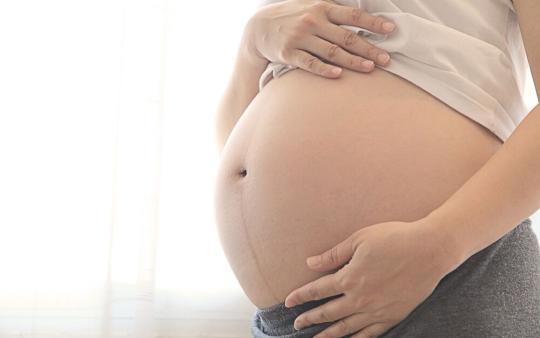Will your abs really split open during pregnancy? Well, If I'm being honest, yes, your abs will likely split during pregnancy. It is actually quite common during and post pregnancy and is called diastasis recti.
How does this happen?
Let’s briefly talk anatomy. The outermost layer of your abs is called the rectus abdominis muscle. The muscle originates at your pubic bone and extends up the midline, past your belly button, inserting at the bottom of your sternum (aka breastbone). The rectus abdominis has both a left and a right half which is connected together by fascia called the linea alba. The widening and thinning of the fascia occurs when your body has to withstand long periods of increased abdominal pressure - as we do during pregnancy. As a result, the right and left halves can separate, leaving you with a gap between your abdominal muscles.
A small amount of widening of the mid line happens in all pregnancies, and it is NORMAL. It only becomes problematic when it is more than 2-2.5 finger widths. Not only can this gap leave you with some serious mummy-tummy postpartum but it also makes you more susceptible to lower back pain, lead to pelvic floor instability, and increase the risk of herniation if it goes undetected and/or untreated.
How is it diagnosed?
Diastasis Reciti can be diagnosed with a simple physical exam by your doctor. Checking at home on a regular basis is not recommended as it requires putting stress on the abdominal muscles which may aggravate a pre-existing diastasis or even lead to one if you're checking often enough. All women should be assessed for the presence of a diastasis by 20 weeks of pregnancy and if one is found, all twisting movements should be eliminated (in workouts and otherwise) in order to reduce any shearing forces applied to the connective tissues of the abdominals as this aggravates the diastasis.
Treatment
Don’t worry, there's hope for your mummy tummy! Most uncomplicated abdominal separations will repair on their own, but there are a few things you can do to help yourself along and in some cases extensive rehabilitation, even surgery, is necessary.
- If you are more than 12 weeks pregnant, be selective with your abdominal exercises. Being pregnant changes your posture because your weight distribution changes drastically over a short period. For this reason, if you choose to engage in abdominal exercises I would urge you to focus on lower spine flexion instead of movements that emphasize upper spine flexion (ex. crunches). Most people concentrate their ab workouts on their rectus abdominis muscle, but don't forget you also have 3 other sets of abdominal muscles (transversus abdominis, external obliques and internal obliques). Your transverse abdominal muscles can be safely exercised from a side-lying, seated or standing position throughout pregnancy and will help support your postural alignment.
- Consider seeing your family care practitioner in order to ensure you are getting appropriate nutrients to support your connective tissues. Naturopathic Doctors are well equipped to guide you through this process and educate you on what your body needs to heal your linea alba.
- Consider visiting a pelvic floor physiotherapist in order to correct your postural alignment during your pregnancy. As your tummy expands, your body will compensate in a number of ways. We're all different when it comes to this, however, we know that our bodies’ weak points become more obvious during this stage of life and addressing them early on can be essential in preventing/reducing severity of a diastasis.
- Make a repair plan! Diastasis recti is becoming more and more recognized within the medical profession and as such many community programs are popping up all over communities in support of mums that are trying to heal during the postpartum stage. Consider calling your local pregnancy and birthing authorities for more information on who is running programs in your area. There are likely classes or workshops you can attend that will teach you safe and effective ways in which to support and rebuild your abdominal wall using slow and controlled engagement of your deep abdominal muscles.
When to see your doctor
Please consult with a medical professional if you experience any redness or pain over the abdomen or continuous vomiting.
Mummy-tummy is nothing to be ashamed of - you housed a baby for 40 weeks (give or take), after all! That said, it's important that we take care of ourselves so that we can be present and actively engaged in our children's lives for years to come. While a lot of diastasis repair programs focus their marketing on making us look pretty, lets keep in mind that the abdominal wall, more than anything, protects our organs and helps hold us up…literally! Assessing and treating a diastasis early on is important not only aesthetically but also functionally. Put yourself first for this one momma! Looking good and feeling great is something we all deserve - making time to prevent and treat this issue will only enforce to your kids that taking time for your health is a non-negotiable.






